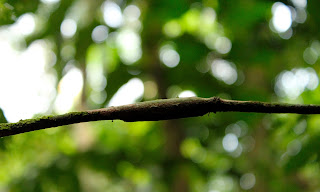January 22 2013
My first full day in the Amazon was filled with hikes. I got up at 6 am for breakfast and then proceeded to go on the Lago trail with Sarah, Morgan, Steven, James, and our professor Esteban.
One of the first things we did was investigate the soil structure. We got sticks and tried to dig little holes, but it was difficult because of the clay. The soil structure in the rain forest is different than I am used to, with a layer of leaves, a thin layer of organic nutrients, and then a large layer of clay.
 |
| leaf litter |
 |
| the small hole i dug |
We also saw different kinds of plants on our hike. One type has tall roots that are exposed above the soil, called stilt roots. This structure could be used for increased potential for vertical growth or as adaptation for stability in sloped terrains. These trees are able to reach higher in the canopy without needing a wider trunk. Some of the plants with stilt roots are walking palms. When some roots on the outside die, they are replaced by new ones on the other side, causing the tree to move over the course of a few years.
 |
| new roots; the rough structure can be used for grating vegetables |
 |
| initial sprouting of root growth |
 |
| stilt roots covered in epiphytes |
There are also many lianas in the rain forest. These are woody vines that are like flexible trees. They ascend to the canopy using the structure of other plants and are thus structural parasites. Lianas are well-adapted to their environment. They may put enough physical stress on other trees so that they collapse, but their flexibility allows them to climb other trees.
The rain forest floor is generally dense with plants, but we came across an area with a few small trees and no other plants in the area. This seemingly strange change in vegetation is due to the symbiotic relationship between lemon ants and their host trees. The ants protect the tree from other vegetative competition and the trees provide a home for the ants. They make small bulges in the tree and are concentrated there. Some people in my group tried the lemon ants, but I thought it was kind of icky and decided against it.
The best part of the hike was the lake. We eventually reached a small pond-like lake and took a canoe ride around it. I was especially excited because of the birds we got to see! My favorite was the
hoatzin. We also saw cacique birds, which hang their nests from trees as a way to deter predators from the eggs.
 |
| hoatzins :] |
 |
| cacique in flight with nests hanging in the trees below |
 |
| more hoatzins :D |
 |
| James helped paddle |
 |
| another hoatzin photo... I have a bird problem |
 |
| unidentified egret/heron/crane bird |
 |
| cacique in flight |
 |
| cacique in flight again :] |
Once we got back on land, we investigated the leaf cutter ants. These ants are fungal farmers--they cut leaves to grow fungus on and then eat the fungus. We stepped off the path and found their nest, which encompassed a clearing in the forest floor, about 4x4 m.
 |
| for some reason, i found the ants precious |
 |
| leaf litter near the nest |
 |
| quaint fungal farmers |
 |
| the nest |
Luckily, we didn't get lost in the forest and made it back to the trail. We saw a few more interesting things on the way back to camp.
 |
| caterpillar that was most likely poisonous |
 |
| tree leech |
 |
| excellent example of epiphytes |
 |
| moth |
 |
| so much fungus |
 |
| translucent butterfly |
 |
| one of the bridges over a stream we crossed |



























Love the pictures. Sounds like you had a great time. Miss you.
ReplyDeleteLove, Mom